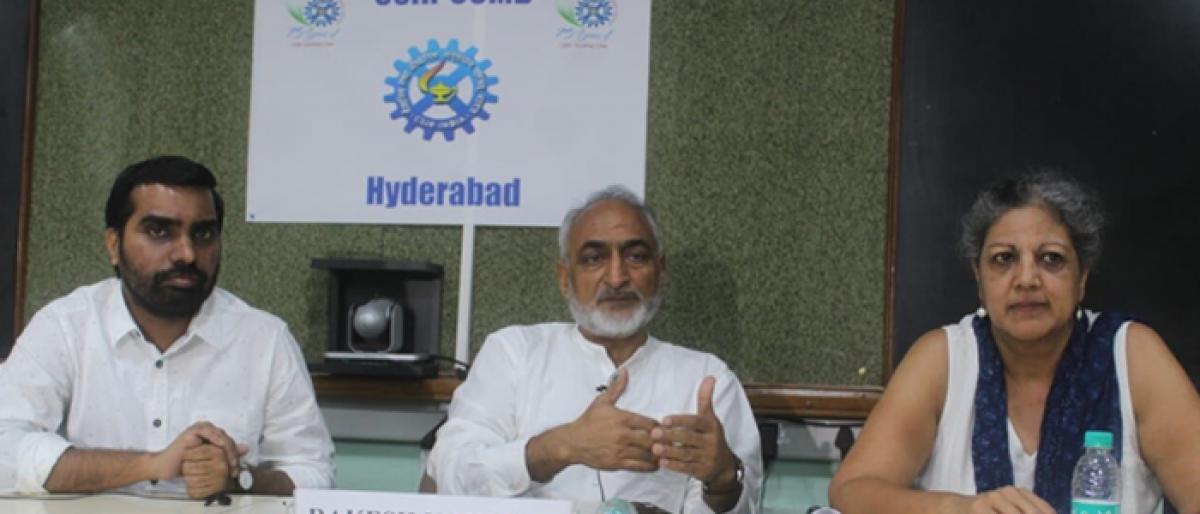Live
- Today's Horoscope for January 10, 2025: Unlock the Powerful Daily Insights of Your Zodiac Sign
- Bengal fake passport racket: Role of verification officers under scanner
- SC stays GST show-cause notices to online gaming sector in temporary relief
- Sambhal mosque row: SC stays implementation of notice relating to well
- SS Rajamouli Unveils India’s First Dolby Certified Postproduction Facility for Cinema & Home at Annapurna Studios
- Divi turns heads with a bold look
- Nikki Tamboli stuns in Dubai
- Amritha Aiyer and her sense of fashion
- Rowdy Sheeter Badruddin Arrested in Mangaluru Gun Firing Case
- Dressing up for the first Lohri: Ethnic looks That shine bright
Just In

Muscular dystrophy is one of the rare diseases for which there is no cure Muscular dystrophy is caused by genetic mutations that interfere with the production of muscle proteins that are needed to build and maintain healthy muscles
Hyderabad: Muscular dystrophy is one of the rare diseases for which there is no cure. Muscular dystrophy is caused by genetic mutations that interfere with the production of muscle proteins that are needed to build and maintain healthy muscles.
However, patients affected by this dreaded disease can hope for a cure in the near future. CCMB researchers, after a 6-year study discovered a pathway that was published in the acclaimed journal Science Signalling this week. This will now pave way for advanced studies on mice to further understand how it can be put to application for preparation of drugs for treating affected patients.
CCMB director Dr Rakesh Kumar Mishra, chief scientist Dr Jyotsna Dhawan and her Ph.D student Ajoy Aloysius shared details of the research findings at a press meet held in CCMB premises on Wednesday. Muscle stem cells (MuSC) also called satellite cells stay in a sleeping or quiet stage, as if silently waiting to be called in an event of an injury.
Apart from major traumatic injuries, even minor stretch injuries when we exercise our muscles by lifting weights in gym are sufficient to send a wake-up call to the MuSCs. When the call comes, they are activated and divide so as to replace the lost cells in the injured tissue.
In conditions like muscular dystrophies, the muscle tissue degenerates and self-renewal of MuSCs are also found to be disturbed. Consequently, the body’s stock of MuSCs cannot keep up with the pace of wear and tear of the muscles. This leads to poor regeneration of muscles leading to wasting. Many labs all over the world are actively studying the molecular players required for maintenance of MuSCs, in order to develop methods to protect muscle from wasting in aging and disease.
Dr Jyotsna Dhawan along with Ajoy Aloysius has worked on the subject where they have been able to identify a pathway in normal mice where the stem cells awakened during an injury and worked towards regeneration. The latest paper from Dr Jyotsna Dhawan’s lab at CCMB was published in “Science Signaling” on July 24.
In patients affected with muscular dystrophy, either the stem cells get exhausted due to the constant work load or they require outside intervention wherein they can work towards repairing, Dr Jyotsna said. Meanwhile, Ajoy stated that this finding will help to devise new therapeutic strategies to enhance the stock of muscle stem cells in diseased muscles.
“Pursuing this line of research can potentially improve muscle regeneration and reduce muscle wasting,” he said. Summing up, CCMB director Dr Rakesh Kumar Mishra said that findings of this study uncovers an important phenomenon in biology and also presents a new area for medical intervention in diseases related to muscle.

© 2025 Hyderabad Media House Limited/The Hans India. All rights reserved. Powered by hocalwire.com







